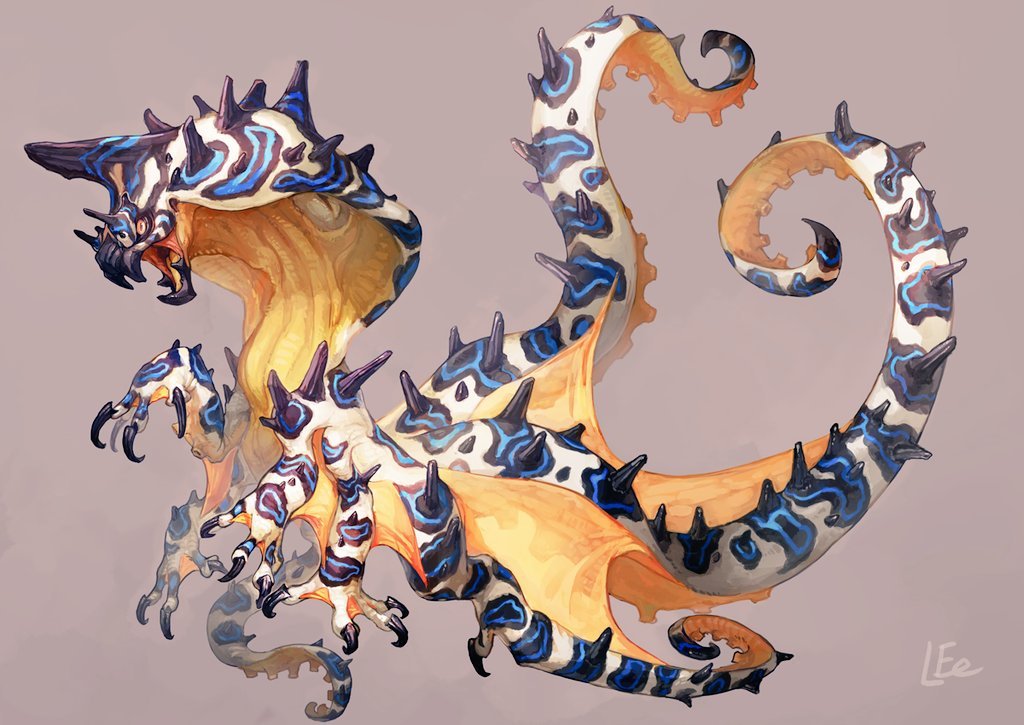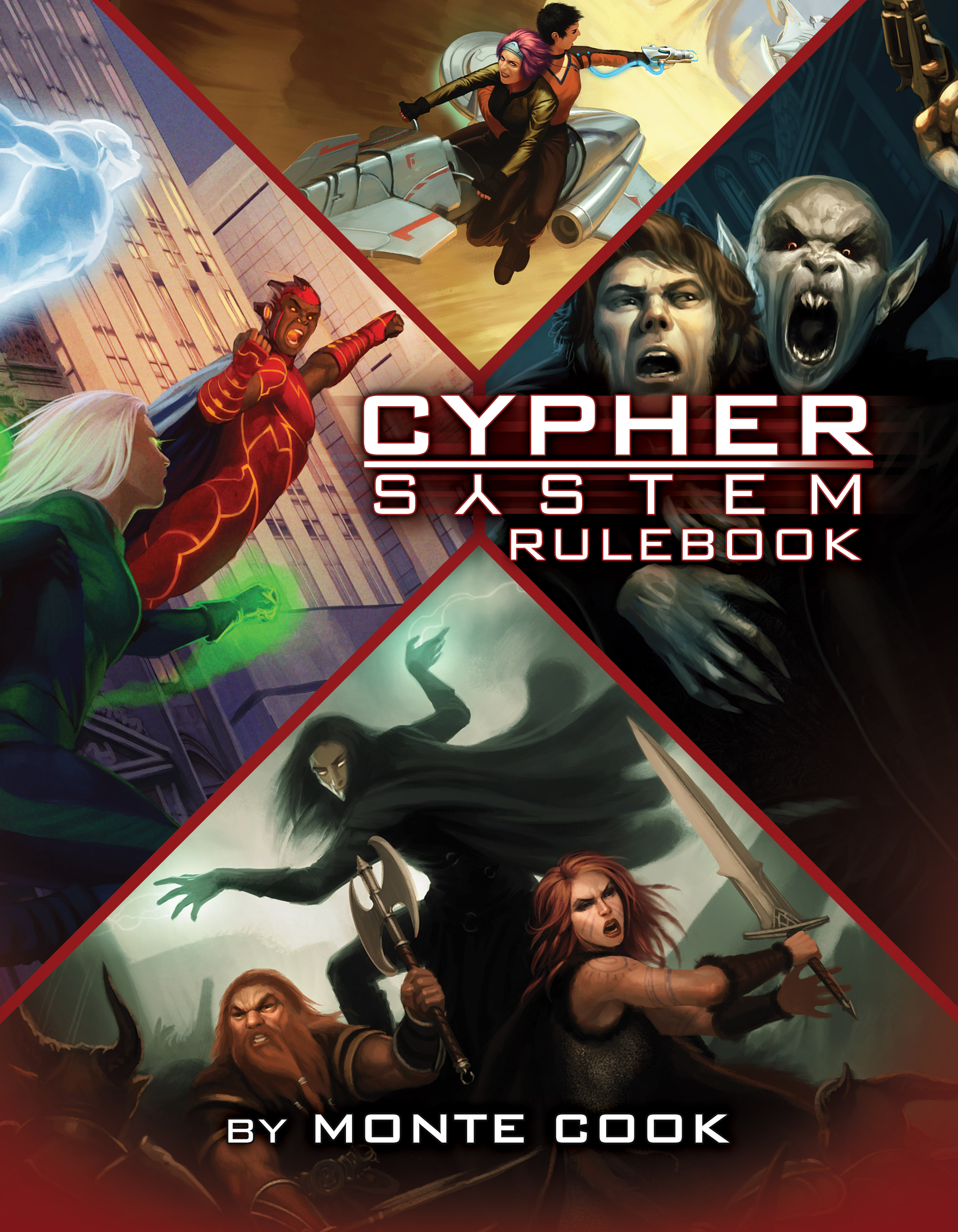
While the bestiaries for Numenera, The Strange, and Cypher System have plenty of wonderful creatures for your players to encounter, sometimes you see something you know your players need to encounter during their adventures.

Octopus Dragon (Level 7)
While it bears little relation to the intelligent octopodes that reside in the deep, the Octopus Dragon was named for it’s resemblance to them. A cunning predator, the Octopus Dragon camouflages itself to match it’s surroundings and ambushes it’s prey. An Octopus Dragon can breath air, but prefers the ocean, where it’s a more effective hunter. Octopodes despise any association with these relatively mindless predators and will pay handsomely to anyone who brings evidence of a successful kill.
Motive: Hungers for flesh
Environment: Anywhere in the Ocean, Solitary
Health: 35
Damage Inflicted: 8 points
Modifications: Stealth as Level 9, Speed Defense as Level 6 due to size
Movement: Short
Combat: The Octopus Dragon can make two attacks in a round, a bite attack, a claw attack, and/or grabbing with it’s tentacles. The bite attack is venomous and requires a Might Defense roll if the attack succeeds. On a failed roll, the victim becomes respiratory muscles begin to seize up, and breathing becomes difficult. They take an additional 2 points of Intellect Damage (then Might, then Speed) each round as oxygen struggles to make it to their brain. To stop the progress of the venom, someone must pass a level 6 heal check, assisting with false respiration.
The tentacle attack prevents the Octopus Dragon from moving, but allows it to grab onto a target, increasing the difficulty of avoiding it’s bite or claws by two levels. To avoid being grabbed, the adventurer must succeed on a Might Defense roll, level 7.
Interaction: The Octopus Dragon is not intelligent like the Octopodes it resembles. It cannot be reasoned with. Patient predators, they use their superior camouflage abilities to blend in the with terrain and attack when prey draws near.
Use: When a party is investigating something on the sea floor or in a coral reef, the Octopus Dragon might be laying in wait. They are drawn to numenera, or semi-precious jewels, and will kill to add them to their hoard.
Loot: Like most dragons, the Octopus Dragon keeps a hoard, usually in a nearby cave. While typically composed of pearls and shells, adventurers may also find several oddities, 2d20 abadis, 2-3 cyphers or even an artifact in the hoard. If time is taken, a careful explorer might be able to extract enough venom for three uses from the mouth of the Octopus Dragon.
GM Intrusion: The PC fails to realize that the Octopus Dragon has another limb that has been camouflaged, and it now uses it to attack the PC.

Mantis Dragon (Level 6)
With a silhouette that shocks with its very wrongness, the Mantis Dragon is an enormous hybrid that is as deadly as it is frighteningly alluring . With their ability to enthrall prey, Mantis Dragons typically wait until their targets are too close to even contemplate escape before capturing them with their hypnotic hum and fluttering of wings. Many an unlucky explorer has been ripped apart by a Mantis Dragon’s powerful forelegs, dumbly smiling all the while.
Motive: Hungers for flesh
Environment: Grasslands, temperate and tropical climates, Solitary
Health: 28
Damage Inflicted: 6
Modifications: Stealth as Level 7, Perception as Level 7
Movement: Short, Long when flying
Combat: The Mantis Dragon has powerful forelegs that it uses to clasp and cut apart it’s prey. Once grasped in the strong forelegs, it’s a difficulty 8 Might Defense roll to escape. The Mantis Dragon does an additional 2 points of damage each round once it has a creature in it’s clutches.
The Mantis Dragon frequently mesmerizes it’s prays with it’s wings. As an action, the Mantis Dragon may spread it’s wings and move towards it’s prey in a slow rhythmic motion, emitting a low hum. Each creature in line of sight must make a Level 6 Intellect Defense roll or become mesmerized by the patterns in it’s wings and the sound it makes. On a failure, the targets are stunned and unable to take actions until the Mantis Dragon ceases it’s dance, or they suffer harm from an attack.
The Mantis Dragon can also bite it’s prey, though it’s preferred attack is to crush a victim in it’s forelegs.
Interaction: Mantis Dragons are predators, and cannot be reasoned with.
Use: The Mantis Dragon, blends into the surrounding environment, rather then tracking it’s prey. The party might venture into its territory and it sees a chance for a meal, or hunters in the region have reported the Mantis Dragon as a threat on their ability to hunt for food for their families.
Loot: Mantis Dragons hide their hoards well, and it will take some time to discover it’s location. The hoard typically consists of 2d20 shins, several oddities, and 2-3 cyphers, taken from previous meals.
GM Intrusion: While an adventurer is in its clasp, the Mantis Dragon takes to the air, and drops them. The adventurer has moments to try to stop their fall.
Images from Gomalemo on Tumblr





 process of character creation through the selection of descriptor, type and focus: the adjective, noun and verb of the statement, “I am a ______ ______ who ______.” The Cypher System also adds a new concept – flavors. You can add a flavor to your type and get some new options for your character to pull from. The flavors include Technology, Magic, Combat, Stealth, and Skills/Knowledge. These let you customize your character a little more, like if you want a talk-y character who is also really good at punching people.
process of character creation through the selection of descriptor, type and focus: the adjective, noun and verb of the statement, “I am a ______ ______ who ______.” The Cypher System also adds a new concept – flavors. You can add a flavor to your type and get some new options for your character to pull from. The flavors include Technology, Magic, Combat, Stealth, and Skills/Knowledge. These let you customize your character a little more, like if you want a talk-y character who is also really good at punching people.
